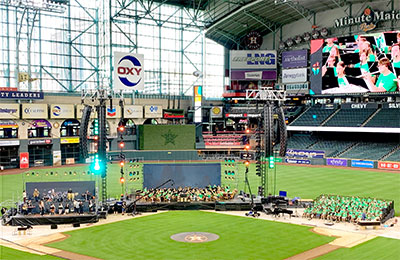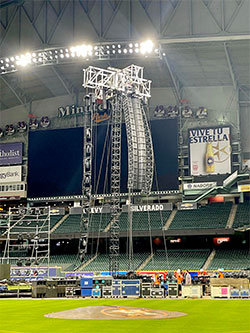Tracing its roots to 1847, the Lutheran Church – Missouri Synod (LCMS) is the second-largest Lutheran body in the US with 1.8m million members. A traditional, confessional denomination, the church recently held its triennial Youth Gathering five-day event, bringing together thousands of young adults across a number of venues in Houston, Texas, the largest being Minute Maid Park baseball stadium.
 LCMS called in Special Event Services (SES) to supply a sound system capable of delivering live music and intelligible speech to an audience of around 20,000.
LCMS called in Special Event Services (SES) to supply a sound system capable of delivering live music and intelligible speech to an audience of around 20,000.
A long-time user of Outline loudspeaker systems, SES deployed part of its GTO inventory to cover the stadium. Four 15-deep arrays were flown from two ground-support towers close to first and third bases, configured as L/R/LL/RR, with low frequency reinforcement provided by 18 LAB 21 infra-subwoofers.
Because no participants were permitted on the field itself, the sound system needed to reach people up to around 91m distant, in the stands. ‘The configuration of the PA allowed me to deploy the system with a sufficient number of tight angles at the top of the array to provide coupling and thus the horsepower necessary for that long throw,’ says Jason Farah. ‘The Smaart traces taken initially at the various seating levels [Levels 100 to 400] were remarkably similar, demonstrating the performance of the GTO system.
‘While I had the ability to EQ the individual zones within the array to even out the possible response curves in the various levels, that was largely unnecessary. The only zone EQ needed was a small HF shelf I put on the bottom three cabinets to reduce the “sizzle” in the nearest zone. That single filter was all that was needed to make all the zones’ response curves lay atop each other. Once that was done, I could apply the overall array tuning, knowing that the experience was consistent throughout the listening space.’
The system relied on a pair of Outline Newton processors, one for each tower: ‘The Newtons’ WFIR filtering technology made tuning the system effortless,’ Farah reports. ‘The result was a totally natural sound at every seat in the stadium. My audio systems assistant, Andrew Steelman, had the opportunity to walk up to the top of the 400-section to the rearmost seats. He said it sounded every bit as good there as anywhere in the stadium.’
 Barry Dixon mixed FOH at the stadium: ‘This was an extremely difficult application for any PA,’ he says. ‘Not only did it have to hang from towers as there was no roof or structure, it was blowing into open mics on three stages and it was hundreds of feet from the audience. It was mission critical to tie the audience to the event by effectively reaching them from an audio perspective with the PA system.
Barry Dixon mixed FOH at the stadium: ‘This was an extremely difficult application for any PA,’ he says. ‘Not only did it have to hang from towers as there was no roof or structure, it was blowing into open mics on three stages and it was hundreds of feet from the audience. It was mission critical to tie the audience to the event by effectively reaching them from an audio perspective with the PA system.
‘The overall cohesiveness of the system across the spectrum was very impressive even at the extreme distance to the crowd – it gave me the impression that there was a single full spectrum point source at the right and left towers. There was no sense of struggling with the cracks between awkward crossover points or between the different transducers in the individual loudspeakers. The system also presented vocals and speech to the audience very effectively – with emphasis on the word “presented”, as one almost got the sense of having the mix served to them. At 300ft away, it did not sound like one had to reach out and have to work to perceive the spoken word or vocal.
‘Subtractive EQ was my predominant approach to the mix because it could be,’ he continues. ‘I know the textbook logic around channel EQ is to concentrate on what one can take away more than on what one can add. That makes sense with a system that cooperates and this one did. I did add some high end to the vocals and sometimes speech but largely the channel EQ was about what I took away. In terms of headroom, there’s plenty of it, the system didn’t fall apart when it was pushed. The system sounds the same, just louder, when more is demanded from it as it does at a nominal level. Its character didn’t change across a dynamic spread.
‘My experience with this system overall was that each instrument shined. We had a steel player and with very little effort, he stood out as a feature very nicely. We had guest cello and violins, they too were featured with very little channel work. The bass with light compression and some subtractive EQ was warm and settled into the mix nicely. The kick, with very little EQ had high end attack that helped its position in the mix. Speech intelligibility was great.’
‘While we deploy GTO often, it never ceases to amaze me with the results we get,’ Farah concludes. ‘Its power, fidelity, and unsurpassed stereo imaging makes it my system of choice. When it comes to large-format events, nothing compares.’















